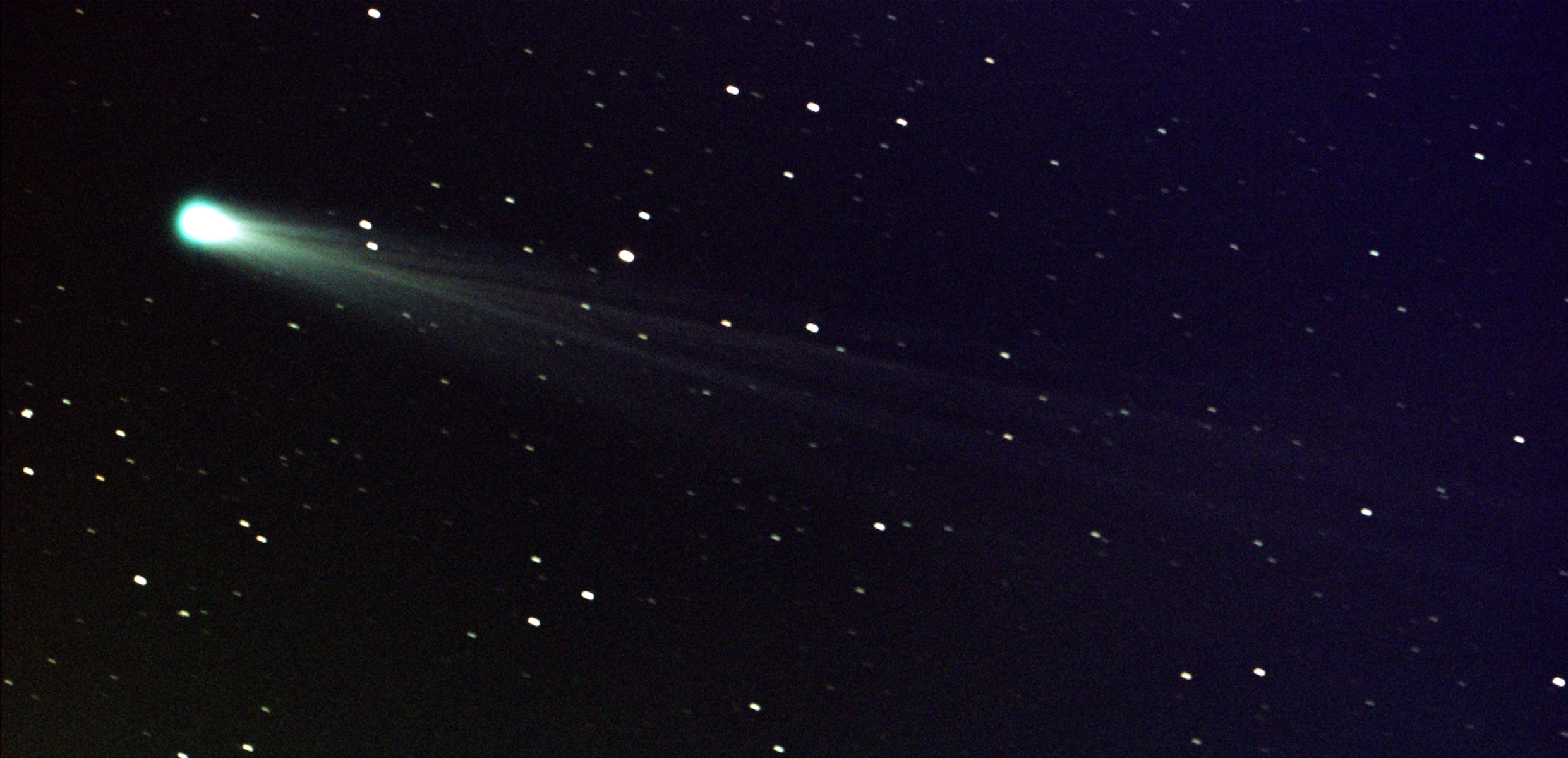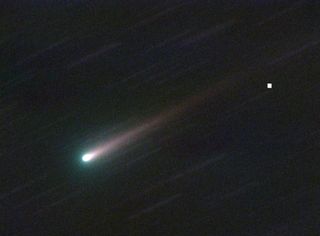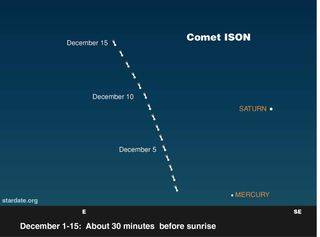
Many skywatchers tracking Comet ISON don't want to get their hopes up about the recent brightening of the possible "comet of the century."
The comet appeared to be floundering, brightening at a disappointingly slow pace as recently as Nov. 12. That day — based on a consensus of observations worldwide — Comet ISON was shining at magnitude 7.9, or more than 3.5 times dimmer than the faintest star visible to the eye without optical aid.
Then suddenly and unexpectedly, the comet brightened. Starting at 7 p.m. EST (0000 UTC) on Nov. 14, the comet's outburst began, and its brightness quickly jumped to magnitude 5.9. By the following day, it had soared to magnitude 5.1 — a more than 13-fold increase in brightness in less than three-days. [See more amazing Photos of Comet ISON by stargazers]
But while the comet's rapid increase in brightness was initially treated as good news, observers now fear that ISON's outburst could signal its demise. There has always been talk that ISON might prematurely break up or disintegrate before it whips to within 730,000 miles (1,175,000 km) of the sun on Nov. 28.
If the comet were to suddenly disintegrate into a cloud of dust around that time it probably would unfurl a long and spectacular tail similar to the one that appeared in December 2011 after Comet Lovejoy's close brush with the sun.
However, if that break-up and disintegration process were to occur many days before perihelion (the comet's closest approach to the sun), then after an initial flare-up in brightness, the comet would begin to gradually fade, eventually becoming lost to view in the glare of the sun, never to be seen again. Such was the fate of Comet du Toit, a sungrazing comet in December 1945.
David Seargent, a well-known Australian comet observer, noted on Saturday (Nov. 16) that Comet ISON was similar to the distance at which Comet du Toitwas observed.
Get the Space.com Newsletter
Breaking space news, the latest updates on rocket launches, skywatching events and more!
"At the time, this comet was intrinsically brighter than Comet Lovejoy at a similar distance, du Toit apparently faded out prior to perihelion," Seargent said. "Time will tell whether the ISON outburst was also cataclysmic or something less destructive."

Astronomer Zdenek Sekanina at NASA's Jet Propulsion Laboratory echoed similar feelings last week: "It is unclear whether this event's nature is benign or cataclysmic."
It's also possible that the sudden brightening of ISON might actually be good news. As the comet continues to be exposed to the increasing light and heat of the sun, a new fissure has possibly opened on the comet's nucleus, which in turn is now expelling a new reservoir of gas and dust.
But at the present nobody can say for sure. Skywatchers will just have to continue monitoring the comet in the days to come as it presses closer to the sun.

Currently about magnitude 5, ISON should be no problem to see. It is dimly visible to the unaided eye, even under the light of the nearly full moon. Some have even reported spotting a faint tail.
Early today (Nov. 20), ISON was positioned roughly between the bright star Spica and the planet Mercury. From here on out, however, it will get harder to see ISON. The comet is now descending into the ever-brightening glow of the rising sun, and after Friday (Nov. 22) the comet will be all but out of sight — hidden by low altitude and the bright dawn twilight.
After that, observers will have to wait about a week until the comet finally skirts the sun's surface. Will the comet survive its close brush with the sun, or will it fizzle? At this point, stargazers will just have to wait and see.
You can follow the latest Comet ISON news, photos and video on SPACE.com.
Editor's note: If you snap an amazing picture of Comet ISON or any other night sky view that you'd like to share for a possible story or image gallery, send photos, comments and your name and location to managing editor Tariq Malik at spacephotos@space.com.
For SPACE.com readers in the New York City area, Joe Rao will be giving a special presentation on Comet ISON at the Hayden Planetarium of the American Museum of Natural History on Tuesday (Nov. 26) at 6:30 p.m. EST (2230 GMT). For more details: http://www.amnh.org/calendar/rendezvous-with-ison-comet-of-the-century-with-joe-rao
Joe Rao serves as an instructor and guest lecturer at New York's Hayden Planetarium. He writes about astronomy for Natural History magazine, the Farmer's Almanac and other publications, and he is also an on-camera meteorologist for News 12 Westchester, N.Y. Follow us @Spacedotcom, Facebook and Google+. Original article on SPACE.com.
Join our Space Forums to keep talking space on the latest missions, night sky and more! And if you have a news tip, correction or comment, let us know at: community@space.com.

Joe Rao is Space.com's skywatching columnist, as well as a veteran meteorologist and eclipse chaser who also serves as an instructor and guest lecturer at New York's Hayden Planetarium. He writes about astronomy for Natural History magazine, Sky & Telescope and other publications. Joe is an 8-time Emmy-nominated meteorologist who served the Putnam Valley region of New York for over 21 years. You can find him on Twitter and YouTube tracking lunar and solar eclipses, meteor showers and more. To find out Joe's latest project, visit him on Twitter.











